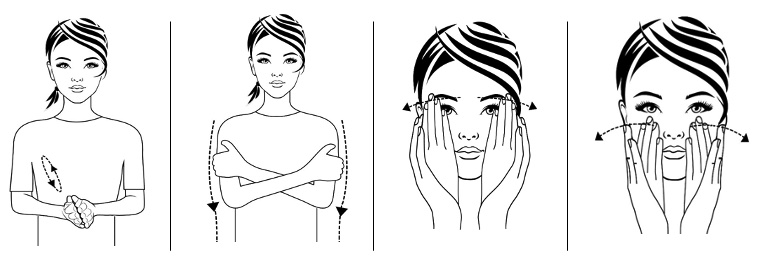Related Resources
For Havening Techniques®
PESI Interview: Havening Techniques® for Treating Trauma, PTSD and Anxiety
Have you heard the buzz about havening?
This neuroscience-based intervention uses similar mechanisms as EMDR to provide fast and effective treatment of PTSD and other fear-based disorders, creating new pathways to sustainable change in your clients’ lives.
Join Dr. Kate Truitt, Havening Techniques Certified Trainer, for this exciting preview of these highly effective and easy-to-use strategies that’ll transform your approach to trauma treatment.
An Introduction to the Havening Touch
Dr. Kate Truitt introduces us to the havening touch in this psychoeducational video. She begins by explaining that havening touch can actually shift the way our brain is functioning in the moment. We have the ability to actually shift the electrochemical experience of our brain.
Havening touch works by utilizing the receptors embedded in the skin. Some respond to fast touch, while some respond to slow, gentle touch. The receptors go up to our brain which interprets the sensation we are experiencing. The havening touch engages C-tactile fibers in our skin that transmit information to our insula and areas of our prefrontal cortex. This can shift the way our brain is interacting in a given moment.
This simple touch doesn’t require a lot of executive function or attention while we do it. Our brain can be engaged in other cognitive exercises at the same time, which empowers the Havening Techniques.
Overcoming Childhood Trauma w/ the Havening Techniques - An Avaiya Interview with Dr. Kate Truitt
Don’t miss this exciting @AVAIYA Founder, iKE Allen Interview (https://www.avaiya.com/) with Ande Anderson and Dr. Kate Truitt where they explore the neuroscience of childhood trauma and how the Havening Techniques empower healing through the effects of childhood trauma to create a thriving life.
Release Stress in 5 min or less! An Intro to Self-Havening with CPR for the Amygdala Practice
CPR for the Amygdala, which utilizes the Havening Touch plus Cognitive Distractions, is a powerful tool for decreasing stress and anxiety rapidly. Join Dr. Kate Truitt to learn how to welcome this powerful tool into your life today!
To start the exercise, Dr. Kate Truitt helps us release anything that has been coming into our mind subconsciously. She then asks us to welcome in havening touch and soothing breath.
Then she asks us to look back and find an experience that has been causing us stress. Once it’s been identified, she leads us to notice all of the sensory aspects of this experience. On a level of 1 to 10, she asks us to evaluate how stressful we rank this experience. After we do this, she guides us through a series of mindful breaths alongside our havening touch.
Once this is done, she asks us to reevaluate how stressful we rank this experience. If it’s still bothering us, she guides us through another round of the exercise. This exercise can be repeated as many times as it takes for us to release the stress surrounding an experience, and it can be repeated for different experiences as well.
The Havening Techniques: New Neuroscientific Insights Shine Light on Ancient Healing Practices
By Dr. Kate Truitt
For centuries, healers have known and used the power of touch in human health care to reduce pain and treat a wide range of chronic and acute conditions. A growing body of modern research has shown that using the touch of a hand on the body can yield a number of positive therapeutic outcomes, including improving immune function, lowering blood pressure, stabilizing heart rates, boosting attentiveness, alleviating depressive symptoms, and reducing stress hormones (Ditzen et al., 2007; Dunbar, 2010; Gallace & Spence, 2010; Grewen et al., 2005; Pawling et al., 2017; Suvilehto et al., 2015).
The Mindful Touch of the Havening Techniques Brings Healing

As you can imagine from several of the therapeutic results listed above, touch can also be used to help heal stress and emotional trauma. In this article I would like to feature “mindful touch,” which is a psychosensory technique. The term “psychosensory” refers to the use of sensory input for psychological healing—such as bilateral stimulation in Eye Movement Desensitization and Reprocessing (EMDR) or tapping on meridian points such as in Thought Field Therapy (TFT) and the Emotional Freedom Techniques (EFT). Often referred to as the third pillar of healing, psychosensory approaches enhance the commonly used therapeutic modalities of relying on language as we do in psychotherapy, or on chemicals as we do in psychopharmacology. Psychosensory treatment has its origins in traditional Chinese medicine and is practiced in applied kinesiology and energy psychology (Mollon, 2007; Diepold & Goldstein, 2008)
Specifically, I want to focus on a specific psychosensory modality that utilizes mindful touch as its primary mechanism of action, the Havening Techniques®. These techniques incorporate mindful touch into a variety of cognitive, somatosensory, and nervous system regulating protocols to significantly decrease the presentation of posttraumatic stress disorder (PTSD) and symptoms of other stress-based disorders including anxiety, depression, panic disorder, phobias, and much more.
I am not presenting Havening Techniques as a standalone therapeutic theory, such as Cognitive Behavioral Therapy or Internal Family Systems. Rather, it is best considered as a bolt-on, neuroscience-based intervention that we can integrate with other treatment modalities so we can enhance and empower the other therapeutic work we do.
The protocols and methods we employ in The Havening Techniques system allow us to create healing by relying on the electrochemical makeup of our brain (Sumich et. al., 2022). The functional mechanisms used are similar to those in EMDR and Tapping, but they include the latest advancements in neuroscience and harness the powerful healing opportunities of mindful touch.
Havening Techniques facilitate rapid, effective release of encoded traumatic memories, using a gentle, client-centered approach. It works by harnessing the power of neuroscience to “depotentiate” traumatically encoded or stress-induced changes that occur in the limbic system of our brain, which is often referred to as our “survival brain.” When we use the term “depotentiate” we mean that we are reversing the effects of the neurons that are responsible for originally encoding a traumatic event (Ruden, 2019).
Studies have found that havening, in as little as one session, is capable of rapidly improving symptoms of depression, anxiety and impaired function, with effects that can last for months (Thandi et al., 2015; Hogdson et al., 2020).
Why Incorporate Havening Protocols?

The effects of living with psychological stress and/or trauma can be devastating and innumerable, disrupting nearly every aspect of a person’s life. These experiences may result in constant irrational fears, inability be in healthy relationships, uncontrollable anger, intractable grief, a sense of being constantly out of control, and much more. Historically, we have gravitated toward the higher cortical functions of our brain—our executive processing centers—in our quest to reduce these painful symptoms and behaviors, using language, logic and rational thought in treatment. With the Havening Protocols we focus on the subcortical levels of the brain—our so-called emotional and survival brain—and the electrochemical activity that is occurring in those areas, especially from the interaction of the thalamus and the amygdala.
Exposure to a traumatic event causes the brain to activate a neurochemical cascade that determines how a person responds to the experience. When we use the term “exposure” there can be several ways this happens. People can be exposed to a traumatic event by having it happen directly to them, such as being assaulted or being in a car accident. They may also be exposed by witnessing that car accident or watching the assault take place on another person. Exposure to a traumatic event may also occur when someone hears a horrific story from someone who experienced that car accident or assault. This type of trauma is known as vicarious trauma.
There are several very specific conditions that need to be met before trauma is encoded, but once they are met, the neurons that encoded that trauma will stay activated permanently, and our amygdala will become triggered any time it recognizes something that reminds it of the activating event (Bechara et al., 2003; Šimić et al., 2021; Sun et al., 2020). That encoded traumatic memory will stay activated until something is intentionally done to deactivate or “depotentiate” it. This is where psychosensory therapy shows its efficacy.
EMDR was the first example of a psychosensory technique gaining wide acceptance in the psychotherapeutic community for use in trauma treatment. EMDR works by using sensory stimuli to shift the brain’s electrochemical response in PTSD and other fear-based responses. More recent neuroscientific research has emphasized how the activation of the receptors that encoded the traumatic experience are maintained and highlights the role of the amygdala and certain glutamate receptors play in the process. Havening Techniques serves to depotentiate these receptors decreasing the presentation of symptoms trauma and other fear-based disorders.
The term “psychosensory” therapy is attributed to Dr. Ronald Ruden, half of the team of twin brothers Drs. Ronald and Steven Ruden, who spent more than a decade developing Havening Techniques (Ruden, 2005). Ronald is an M.D., Ph.D and Steven is a dentist. They introduced their techniques and protocols to the therapeutic world in 2013, so it is a relatively new modality. Their research and development quest began more than a decade before then when renowned British hypnotherapist Paul McKenna posed a question to the Rudens as to why psychosensory therapeutic techniques such as EMDR and Tapping (aka, Thought Field Therapy) are effective.
The impetus for changing the Rudens’ thinking about how the brain encodes and holds onto traumatic memories came from a study by psychophysiologist Melvin Harper (2012). In his research, Harper identified that psychosensory techniques—such as lateral eye movements, hand buzzes and tapping—all created electrochemical changes in the central nervous system and increased the brain’s delta wave activity. This is notable as it is scientifically noted that individuals with PTSD experience an increase in the overall relative presence of the opposite brainwave state, a hypergamma wave (Moon et al., 2018). Hypothetically, increased presence of a delta wave state could counter the effects of increased hypergamma wave power and create a electrochemical state that is permissive for healing.
In his studies Harper measured the effects of stimulating various areas of the body to determine which areas activated delta waves the most. The amount of increase in the presence of a delta wave from stimulating different areas of the body is shown below:
- Cheek—90-fold
- Shoulder—5-fold to 38-fold
- Palms of hands—5-fold
- Back of hands—1.1-fold
- Knee—-fold
- Vibrating pads on palms—-fold to 4-fold
- Lateral eye movement—12-fold to 20-fold
- Gamut Point of the hand—11-fold
- Meridian points vs. non-meridian points—1-fold
The Mechanics of Havening
Havening incorporates the application of touch to four locations found by Harper to exhibit the greatest delta-wave-presence response to touch: the brow, cheek, shoulders, and hands. Havening can be applied either by a clinician or other person (facilitated havening) or by the person themselves (self-havening). It is used along with therapeutic exercises, and meditation and other mindfulness practices.
In addition to increasing the presence of delta waves, the havening touch increases the level of oxytocin, a chemical known for its role in healthy attachment, stress reduction, pain relief, and more (Swaney et al., 2017). The name havening comes from the fact that it creates calm and good feelings and provides a safe haven in which to heal the amygdala.
The following is how the practice works. In this case I am describing self-havening. The two set of diagrams below show how both work.
In the first touch you gently rub your hands together as if you are washing them. With the second touch you give yourself a big, soothing hug, starting with your hands at your shoulders and moving them down slowly and repeatedly over your upper arms to your elbows. Start with your hands together over your face and glide them over your forehead from the middle outward with your fingers. Make sure that all of your movements are smooth and gentle. The fourth touch is like the third, but instead move your hands over your cheeks with that inward-to-outward motion.
If the order I explained above seems unnatural to you, try doing it in reverse, repeating each touch five times—first with the forehead, then move down to your cheeks, then go to your shoulders, and then end with your hands. Then go back to the top and start again. Most individuals eventually find they have a “sweet spot” or “sweet spots” and prefer to focus on their attention on those specific locations. To learn more about the science behind the touch, see the video in the sidebar “An Introduction to the Havening Touch.”
Figure 1: Self-Havening

Source: (Truitt, 2022)
Figure 2: Facilitated Havening

Source: (Ruden, 2011)
For centuries, healers have known that the touch of the hand on the body had incredible, mysterious powers to relieve pain and cure disease in the mind and body. Some developed detailed explanations for why and how these methods worked. In the case of traditional Chinese medicine, some of their interpretations came quite close to our modern understandings, especially about the mind-body connection. But even without the benefit of a precise description of why these techniques were effective, they knew they worked, and so they kept using and refining them.
Through insights gained in neuroscientific research over the past few decades we now have many of the answers those ancient healers were seeking. Havening Techniques is a combination of the ages-old psychosensory healing power of touch combined with awareness of what is happening in that mind-body connection that traumatizes people. With these tools, used in concert with our other healing modalities, we can now release what was once thought to be intractable and put people on a path to healing.
I am excited to announce that my book, titled, “Healing in Your Hands: Self-Havening Practices to Harness Neuroplasticity, Heal Traumatic Stress, and Build Resilience” from PESI Publishing is now available for preorder at Amazon and will be released on Dec. 6, 2022. If you would like to learn more about self-havening and how to put its healing power in your hands, I believe this book may be for you. Healing in Your Hands includes a complete program consisting of simple and effective tools you can use in your daily life for insight and healing.
References
Bechara, A., Damasio, H., & Damasio, A. R. (2003). Role of the amygdala in decision- making. Annals of the New York Academy of Sciences, 985(1), 356–369. https://doi .org/10.1111/j.1749-6632.2003.tb07094.x
Diepold, J. H., & Goldstein, D. M. (2008). thought field therapy and qeeg changes in the treatment of trauma: a case study. Traumatology, 1-9.
Ditzen, B., Neumann, I. D., Bodenmann, G., von Dawans, B., Turner, R. A., Ehlert, U., & Heinrichs, M. (2007). Effects of different kinds of couple interaction on cortisol and heart rate responses to stress in women. Psychoneuroendocrinology, 32(5), 565-74.
Dunbar, R. I. M. (2010). The social role of touch in humans and primates: Behavioural function and neurobiological mechanisms. Neuroscience & Biobehavioral Reviews, 34(2), 260–268. https:// doi.org/10.1016/j.neubiorev.2008.07.001
Gallace, A., & Spence, C. (2010). The science of interpersonal touch: An overview. Neuroscience & Biobehavioral Reviews, 34(2), 246–259.
Grewen, K., Girdler, S., Amico, J., & Light, K. (2005). Effects of partner support on resting oxytocin, cortisol, norepinephrine, and blood pressure before and after warm partner contact. Psychosomatic Medicine, 67, 531-538.
Harper, M. (2012). Taming the amygdala: An EEG analysis of exposure therapy for the traumatized. Traumatology, (18)2 61-74.
Hogdson, K. L., Clayton, D. A., Carmi, M. A., Carmi, L. H. Ruden, R. A., Fraser, W. D. & Cameron, D. (2020). A psychophysiological examination of the mutability of Type D personality in a therapeutic trial. Journal of Psychophysiology, 35, 116-128. https://doi.org/10.1027/0269-8803/a000266.
Mollon, P (2007). Thought field therapy and its derivatives: Rapid relief of mental health problems through tapping on the body. Primary Care and Community Psychiatry. 12 (3–4): 123–127.
Moon, S. Y., Choi, Y. B., Jung, H. K., Lee, Y. I., & Choi, S. H. (2018). Increased Frontal Gamma and Posterior Delta Powers as Potential Neurophysiological Correlates Differentiating Posttraumatic Stress Disorder from Anxiety Disorders. Psychiatry investigation, 15(11), 1087–1093. https://doi.org/10.30773/pi.2018.09.30
Pawling R, Cannon PR, McGlone FP, Walker SC, (2017). C-tactile afferent stimulating touch carries a positive affective value. PLoS ONE 12(3): e0173457. doi:10.1371/journal. pone.0173457
Ruden, R. A. (2005). A neurological basis for the observed peripheral sensory modulation of emotional responses. Traumatology. 11(3): 145–158. doi:10.1177/153476560501100301.
Ruden, R. (2011). When the past is always present: Emotional traumatization causes and cures. Routledge.
Ruden, R. A. (2019). Harnessing electroceuticals to treat disorders arising from traumatic stress: Theoretical considerations using a psychosensory model. EXPLORE, 15(3), 222–229. https://doi.org/10.1016/j.explore.2018.05.005
Šimić, G., Tkalčić, M., Vukić, V., Mulc, D., Španić, E., Šagud, M., Olucha-Bordonau, F. E., Vukšić, V., & Hof, P. R. (2021). Understanding emotions: Origins and roles of the amygdala. Biomolecules, 11(6), 823. http://dx.doi.org/10.3390/biom11060823
Sumich, A., Heym, N., Sarkar, M., Burgess, T., French, J., Hatch, L., & Hunter, K. (2022). The power of touch: The effects of havening touch on subjective distress, mood, brain function, and psychological health. Psychology & Neuroscience. Advance online publication. https://doi.org/10.1037/pne0000288
Sun, Y., Gooch, H., & Sah, P. (2020). Fear conditioning and the basolateral amygdala. F1000Research, 9. https://doi.org/10.12688/f1000research.21201.1
Suvilehto, J. T., Glerean, E., Dunbar, R. I. M., Hari, R., & Nummenmaa, L. (2015). Topography of social touching depends on emotional bonds between humans. Proceedings of the National Academy of Sciences, 112(45), 13811–13816. https://doi.org/10.1073/pnas. 1519231112
Swaney, W.T., Walker, S.C., Trotter, P.D., Marshall, A., and McGlone, F.P. (2017). C- tactile afferents: Cutaneous mediators of oxytocin release during affiliative tactile interactions? Neuropeptides. ISSN 1532-2785
Thandi, G., Tom, D., Gould, M., McKenna, P., Greenberg, M. (2015) Impact of a single-session of havening. Health Science Journal, (9), 5:1.
Truitt, K. (2022). Healing in your hands: Self-havening practices to harness neuroplasticity, heal traumatic stress, and build resilience. PESI Publishing.










